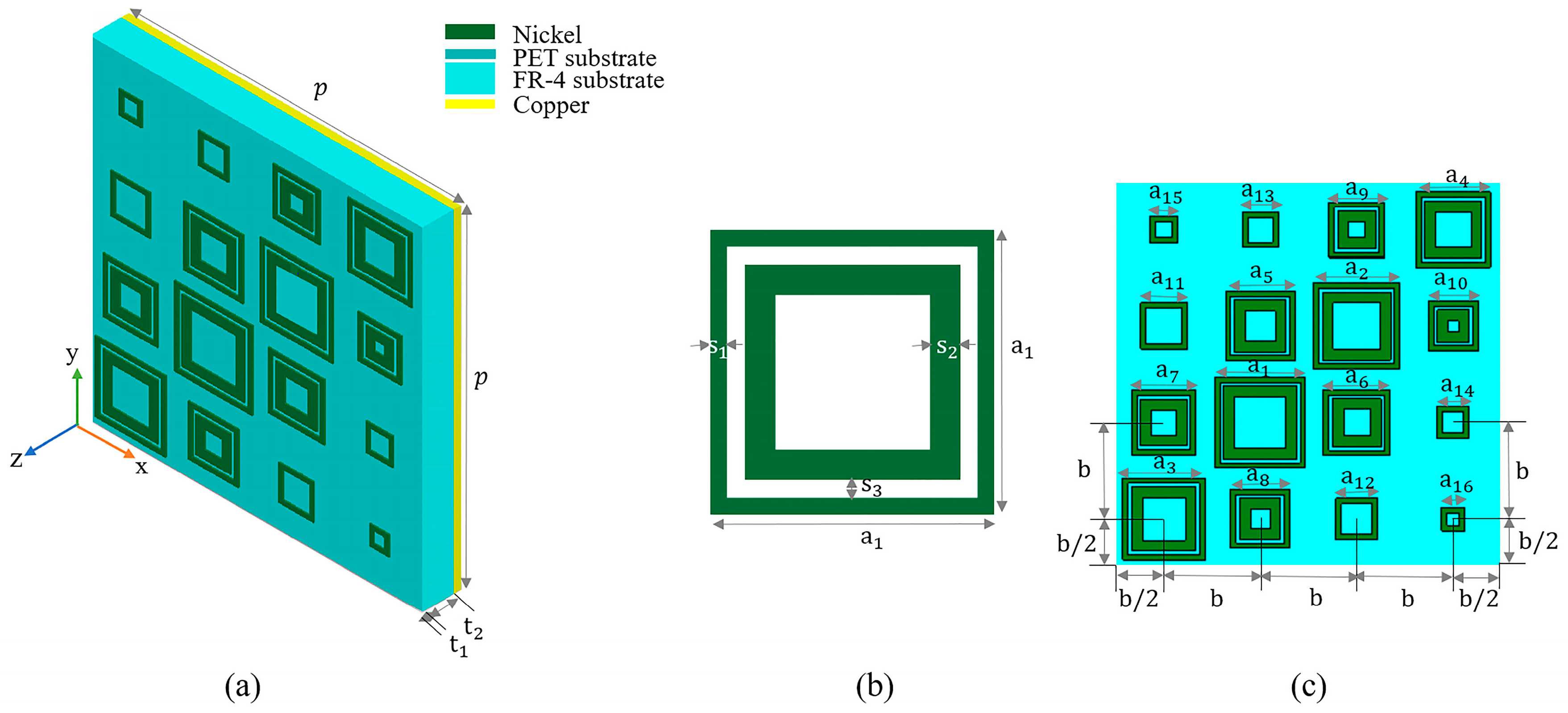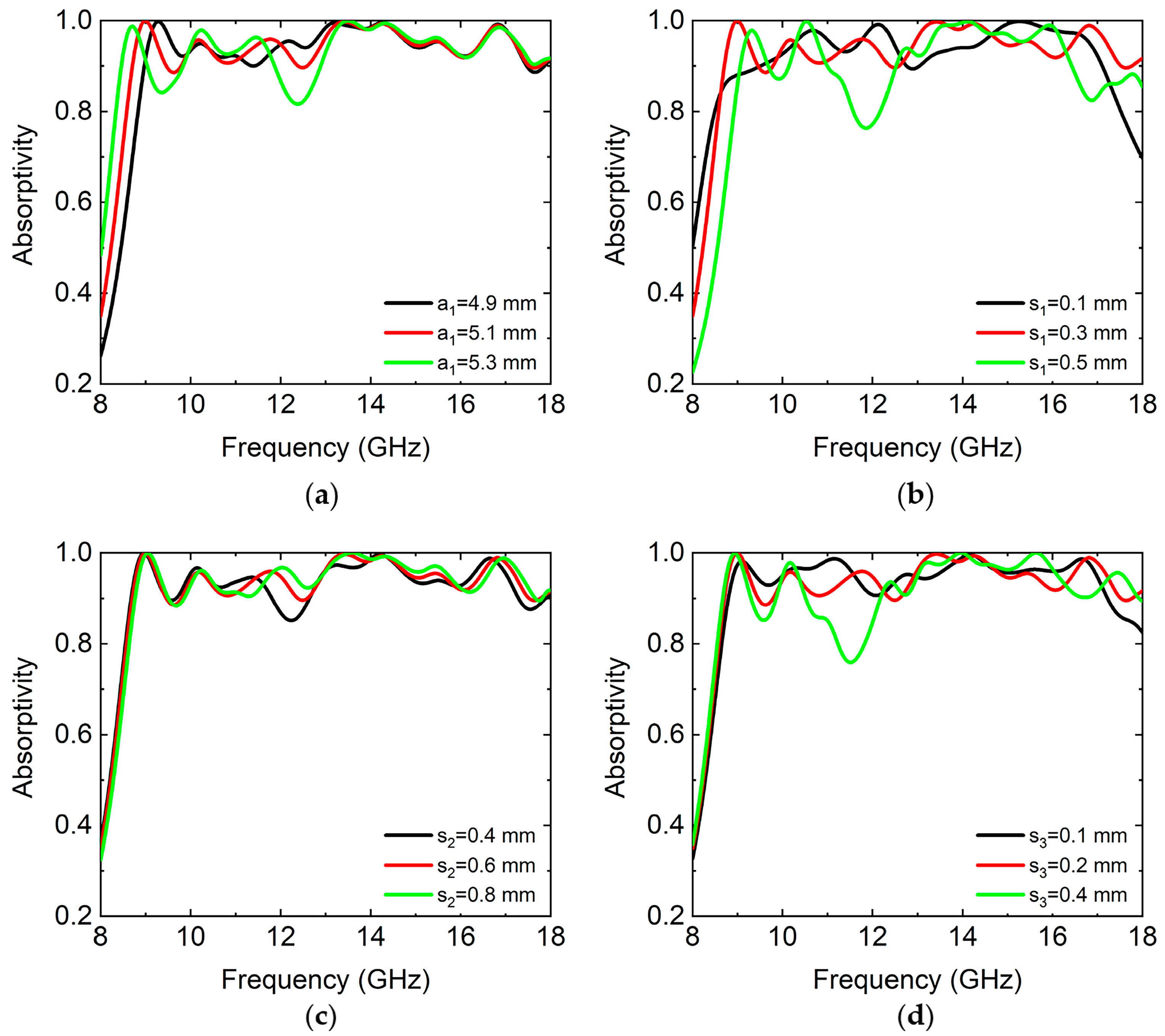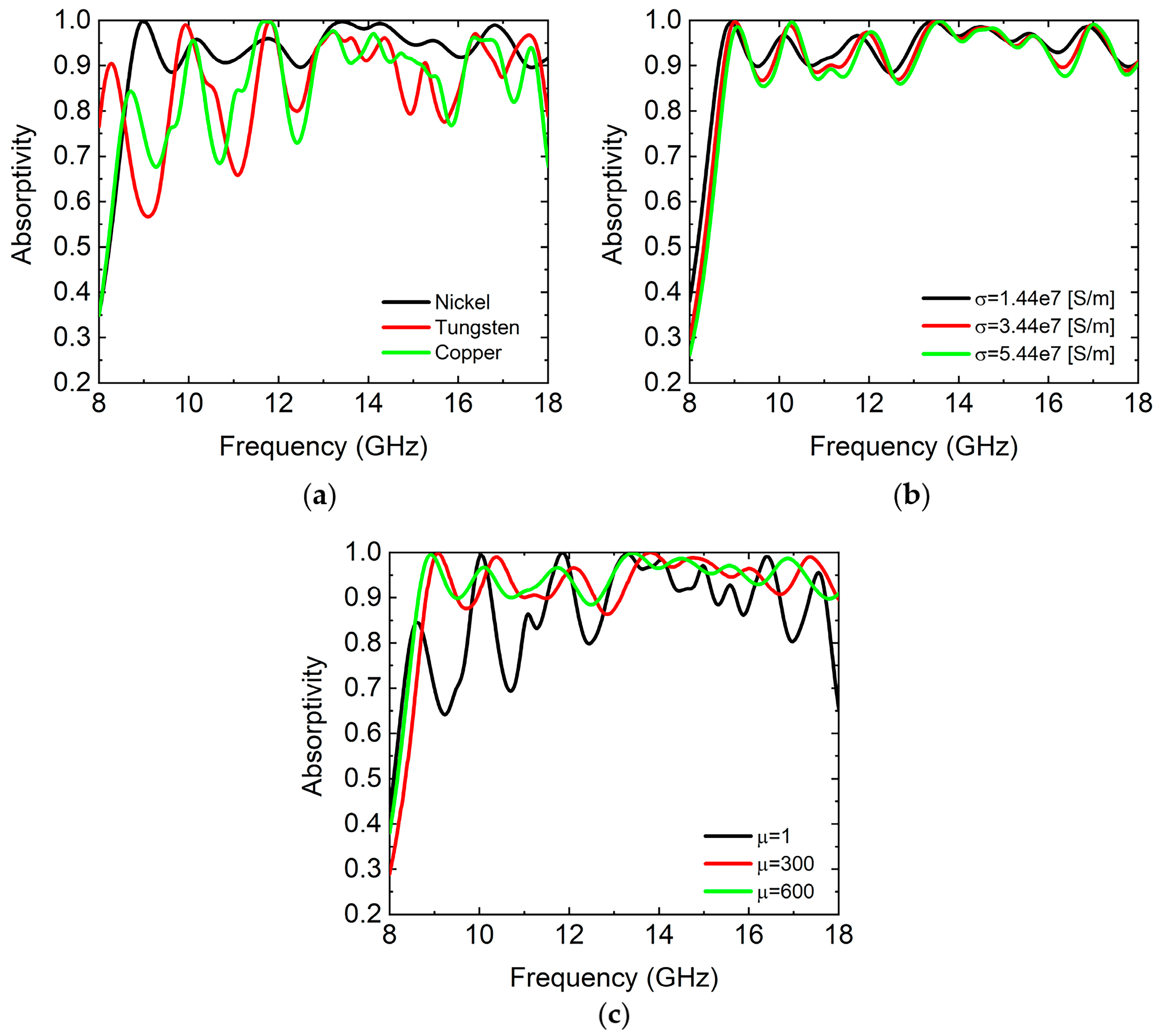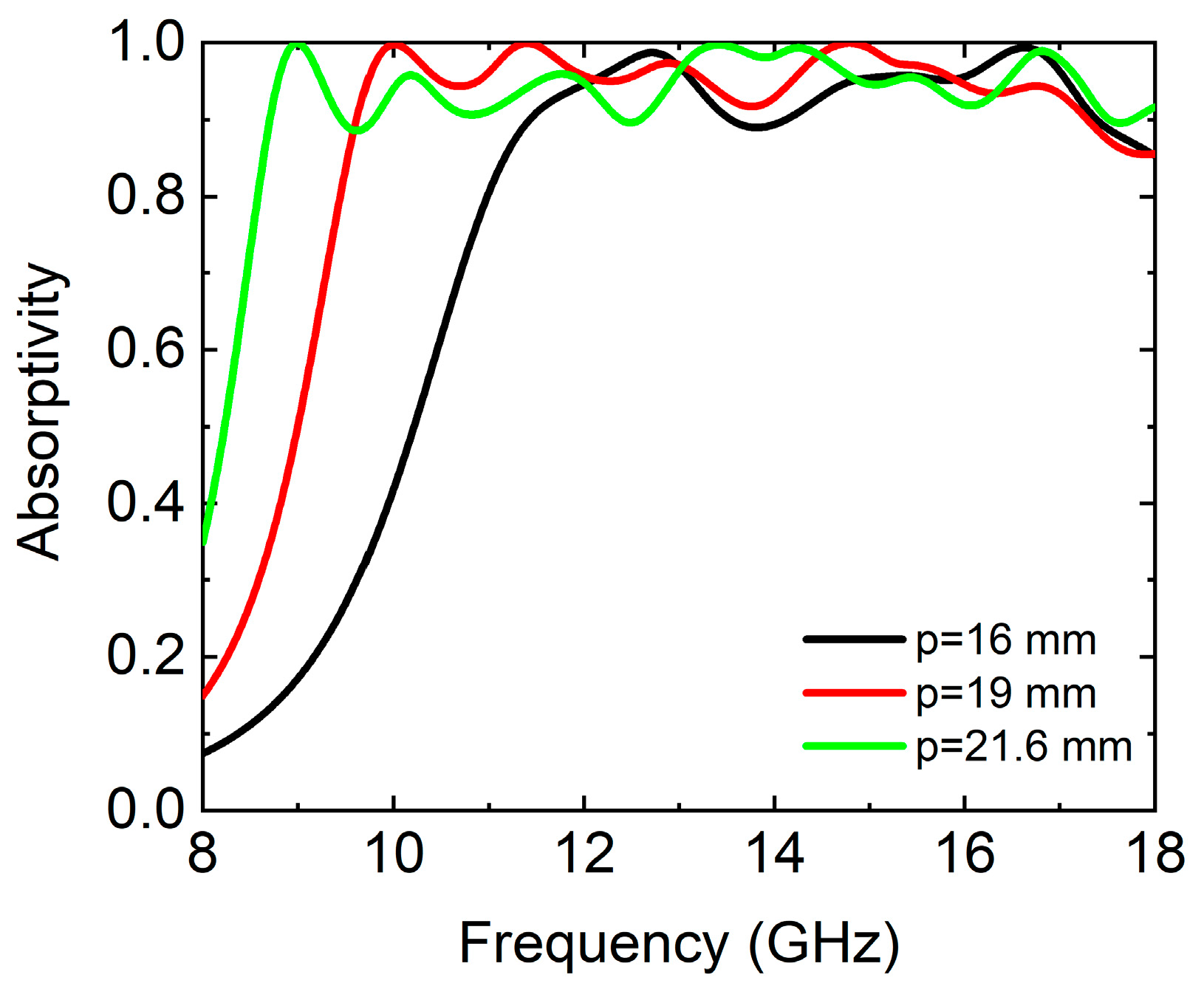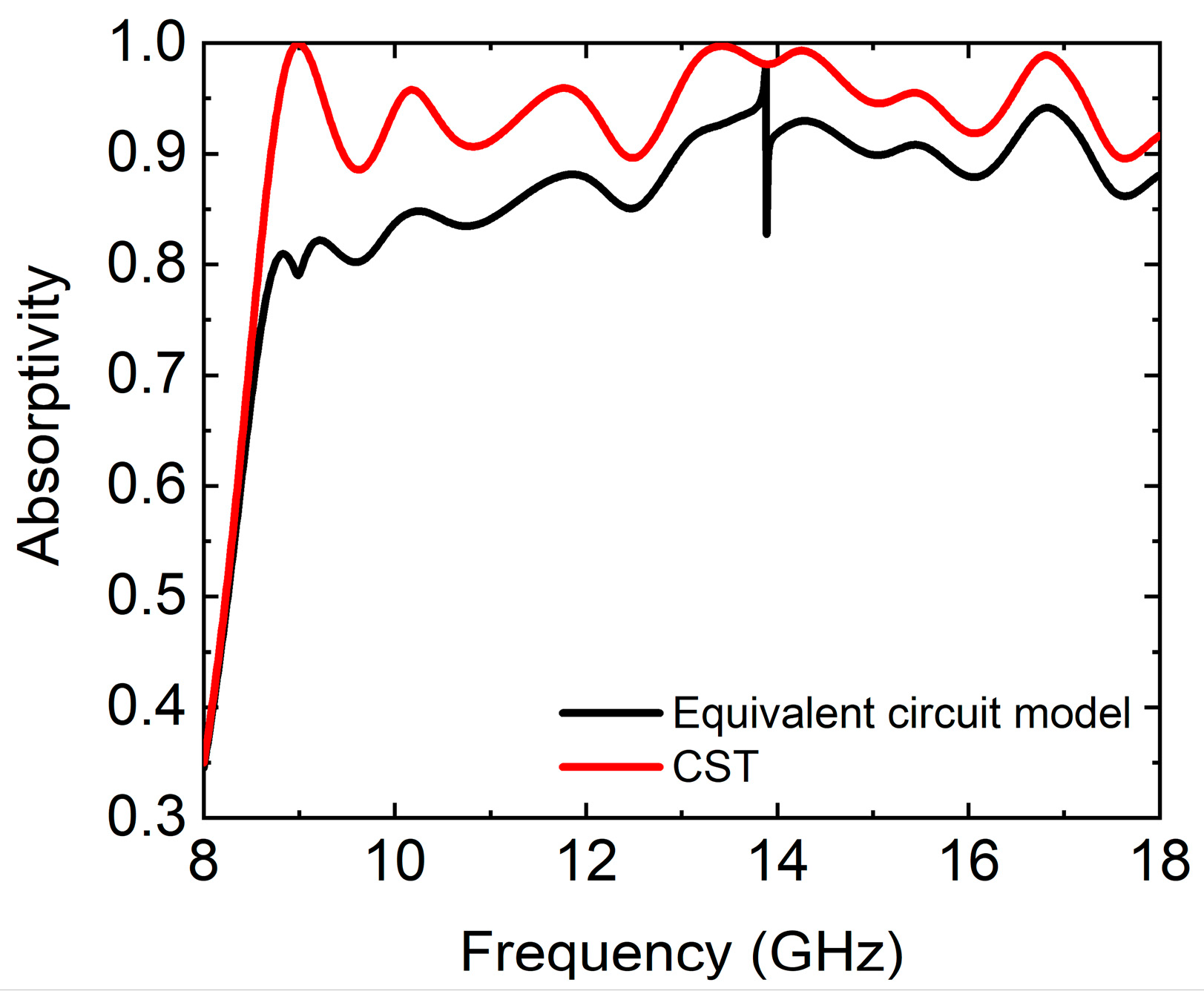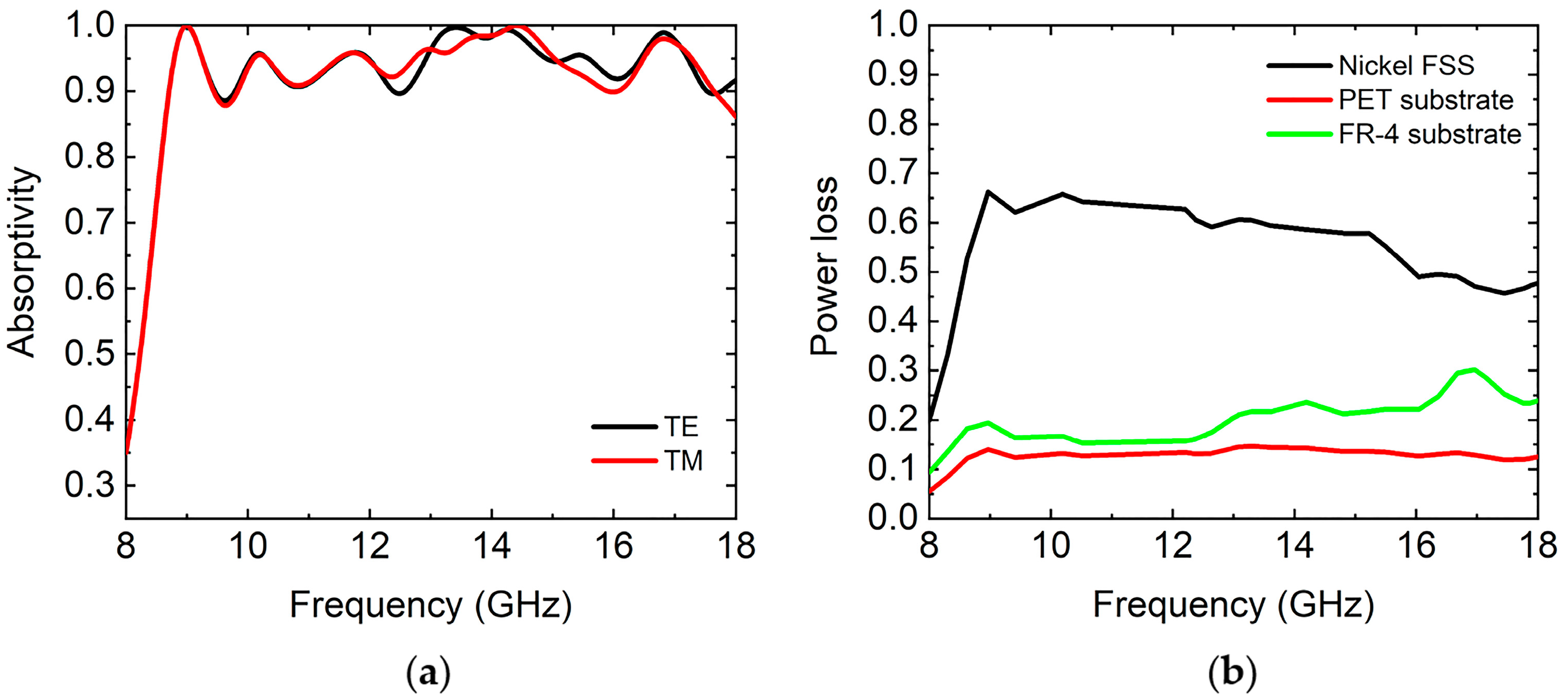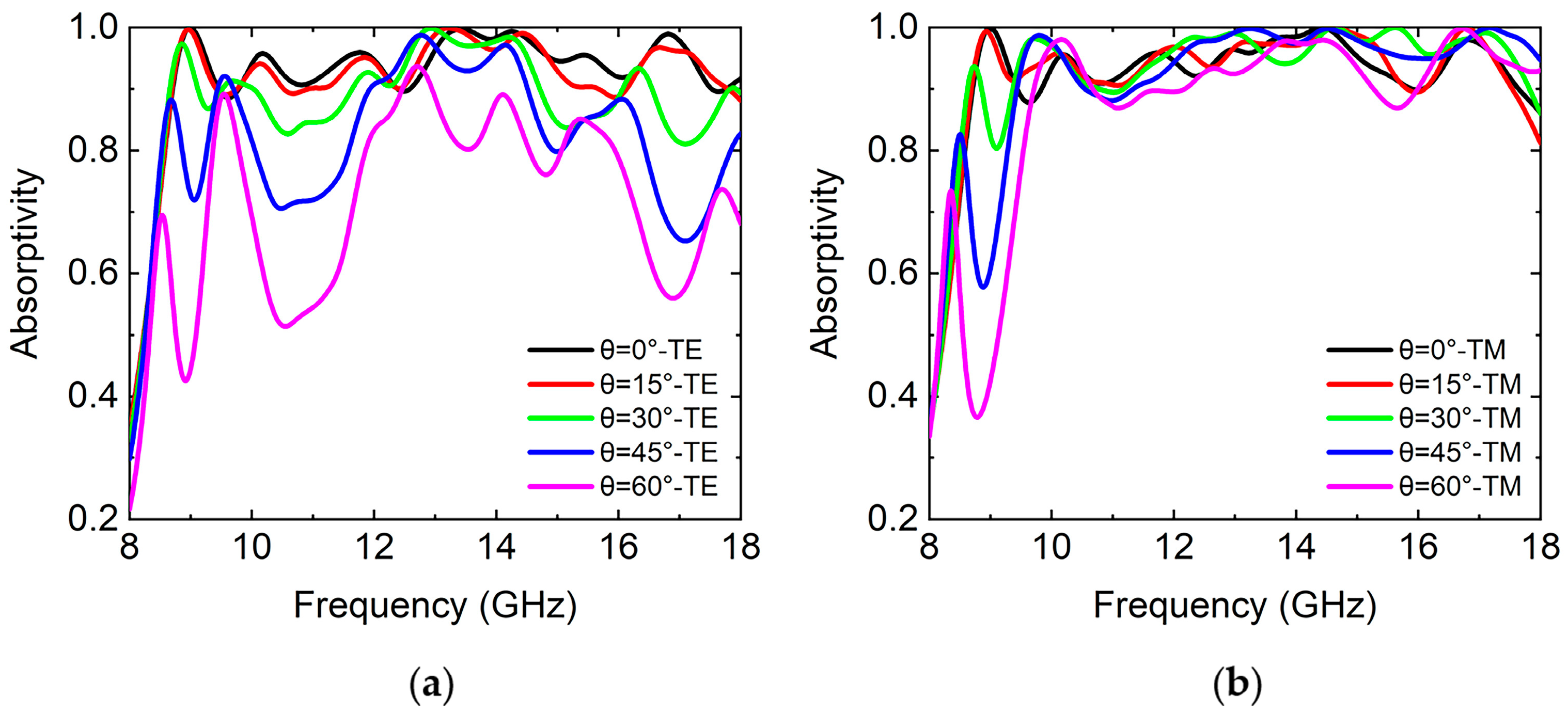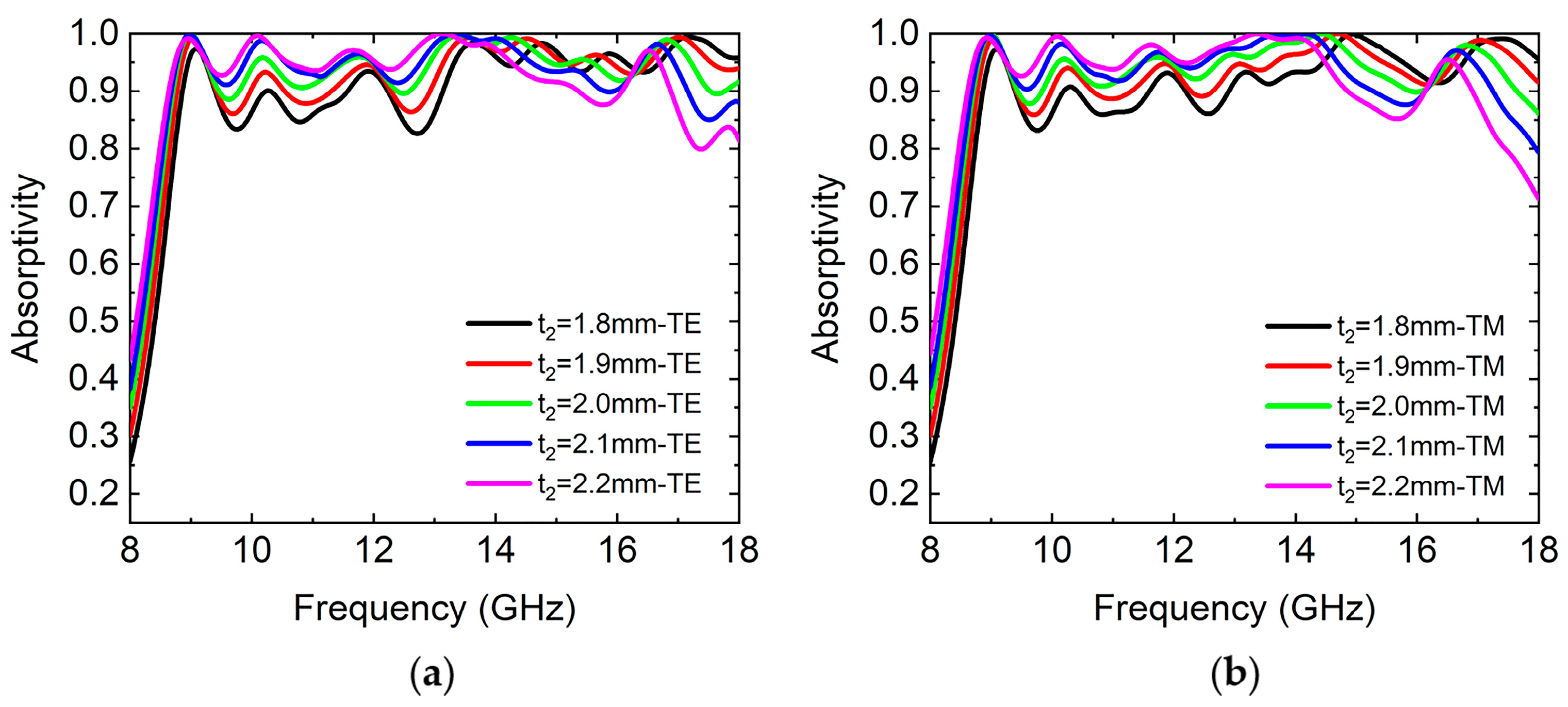2. Absorber Design and Methods
The structure of the unit cell of the designed microwave absorber is depicted in
Figure 1. The nickel square loop array was used as an FSS to form the top layer. Nickel has an electric conductivity of
and a magnetic conductivity of
. The thickness of the nickel layer was 0.018 mm and the sizes of the square loop were optimized as follows: The geometry parameters were designed as
= 5.1 mm,
= 4.8 mm,
= 4.6 mm,
= 4.2 mm,
= 3.9 mm,
= 3.7 mm,
= 3.6 mm,
= 3.3 mm,
= 3.1 mm,
= 2.8 mm,
= 2.6 mm,
= 2.3 mm,
= 2 mm,
= 1.8 mm,
= 1.5 mm, and
= 1.3 mm, respectively. The substrate was polyethylene (PET); the PET had a relative permittivity of
and thickness of
= 0.05 mm. The middle FR-4 substrate had relative permittivity of
and thickness of
= 2 mm. The bottom layer was a uniform copper plate with an electric conductivity of
, and the thickness was 0.018 mm. The period length of the unit cell was
p,
p = 21.6 mm. The width of the nickel outer square loop
was 0.3 mm, the width of the inner square loop
was 0.6 mm, and the distance between the two square loops
was 0.2 mm. The square loops were arranged equally in the center spacing with a spacing of b = 5.4 mm.
Based on the impedance matching theory [
21] and equivalent circuit model of the square loop [
22,
23], we conducted modeling of a microwave absorber. The equivalent circuit of the unit cell of the absorber is depicted in
Figure 2. The unit cell contained several square loops. The single square loop was equivalent to a resistance-inductance-capacitance (R-L-C) circuit. The combined effect of all square loops was equivalent to connecting all square loops parallelly. The equivalent circuit is depicted in the dashed box in
Figure 2. The resistance was generated by the ohm lossy property of FSS, inductance was generated by the square loop, and capacitance was generated by gaps between adjacent loops.
The double square loops were equivalent to two parallel resistance-inductance-capacitance (R-L-C) circuits. The
− effective circuit was derived for the double square loop array. At normal incidence, the inductance
and capacitance
of the double square loops of FSS were calculated by the following formulas [
22]. The equivalent circuit for the double square loop array was derived from reference [
22]. The basic equations for calculating the inductance and capacitance of strip gratings are found in Marcuvitz.
where
, ,
, and
are the inductance and capacitance of the double square loops, respectively.
ω is the operating radian frequency and
is the wavelength.
is the impedance of the air.
p is the period of the unit cell,
is the side length of the square loop,
is the outer square loop width,
is the inner square loop width, and
is the distance between the two square loops.
s in (5), (6), and (8) equals
,
,
,
p − , and
to calculate
, ,
, and
.
The
- effective circuit was derived for the single square loop array. At normal incidence, the inductance (
) and capacitance (
) of the single square loop of FSS were calculated by the following formulas [
23]. The inductance and capacitance were determined by the parameters of a single square loop of FSS.
where
and
are the inductance and capacitance of the single square loop, respectively.
ω is the operating radian frequency and
is the wavelength.
is the impedance of the air.
p is the period of the unit cell,
is the side length of the square loop, and
is the loop width.
s in (5), (6), and (8) equals
2 and
p- to calculate
and
.
The ohm resistance of FSS was determined as
where
ω is the operating radian frequency,
µ is the effective permeability of the metal square loop, and
σ is the effective conductivity of the metal square loop. The combined effect of all square loops was equivalent to connecting all square loops parallelly. The total impedance of FSS was defined as follows [
24]:
where
is the total effective resistance of FSS,
is the total effective inductance of FSS, and
C is the total effective capacitance of FSS.
The two-port network model could be used to calculate the reflection of the cascading structure by multiplying ABCD matrices in series [
25,
26]. The ABCD matrix of a dielectric layer under the normal incidence is defined as
where
and
are the wavenumber and intrinsic impedance of the dielectric layer (PET and FR-4 substrate), respectively.
and
are the thickness and complex permittivity of the dielectric layer (PET and FR-4 substrate), respectively. The ABCD matrix of the nickel FSS was defined as
The proposed equivalent circuit model can be regarded as a two-port network being short-circuited at the end. By generating the transmission matrix of each segment, the total transfer ABCD matrix could be obtained. The total transfer ABCD matrix of the composite film is defined as
where the coefficients
A,
B,
C, and
D represent the terms of the total transfer ABCD matrix of the composite film. The composite film was composed of a frequency selective surface (FSS) and a general number of dielectrics.
The reflection coefficient of the absorber was defined as
The reflectivity was .
Based on the impendence matching theory [
21], the reflection coefficient of the absorber was defined as
The reflectivity was
. For details about the physical parameters, see the previous description. According to (19), if the impedance of the absorber
matches the impedance of the air
,
The reflectivity was zero because the bottom layer of the composite thin film absorber was copper with a thickness of 0.018 mm, which was much thicker than the skin depth of the incident wave in this frequency band, so the transmittance was zero. Thus, the absorptivity was A = 1 − R.
We performed simulations of the absorption properties of the absorber using CST (computer simulation technology) Microwave Studio [
27]. For the electromagnetic field full-wave simulation, the finite integration technique (FIT) was used. Full wave simulation refers to solving the unapproximated Maxwell’s equations in boundary conditions in the simulation. Periodic boundary conditions were adopted in the x and y directions. The distribution of ε and μ was a periodic function in the x, y direction, with period
p satisfying ε(x +
p) = ε(x), μ(x +
p) = μ(x), ε(y +
p) = ε(y), and μ(y +
p) = μ(y); an open boundary condition was adopted in the z direction. The structure of the unit cell for the absorber is depicted in
Figure 1. The working frequency ranged from 8 GHz to 18 GHz.
In order to expand the absorption bandwidth, we optimized the side lengths of the square loops on the top metal FSS of the absorber. The side length of the square loop decreased in turn. For this, we also nested a square loop inside a square loop. The absorption spectrums of the absorber with different side lengths of the square loop (
), outer square loop widths (
, inner square loop widths (
, and distances between the two square loops (
were simulated at normal incidence of the TE wave, as shown in
Figure 3, respectively. We set the side lengths of the square loop as
= 4.9, 5.1, and 5.3 mm, respectively. From
Figure 3a, we found that when
increased, the absorption spectrum was redshifted and enhanced low-frequency absorption. But, when
= 5.3 mm, the local absorption intensity decreased. The average absorptivity in the frequency range of 8.7–18 GHz was 95.1%, 95.1%, and 94.4%, respectively. We set the outer square loop widths as
= 0.1, 0.3, and 0.5 mm, respectively. From
Figure 3b, it can be seen that when
increased, the absorption bandwidth increased at first and then decreased. When
= 0.1 mm, the local absorption intensity decreased in the frequency range of 17–18 GHz. When
= 0.5 mm, the local absorption intensity decreased in the frequency range of 11–12.5 GHz. The average absorptivity in the frequency range of 8.7–18 GHz was 94.3%, 95.1%, and 92.6%, respectively. We set the inner square loop widths as
= 0.4, 0.6, and 0.8 mm, respectively. From
Figure 3c, we found that when
increased, the change in the absorption spectrum was not obvious. The local absorption intensity increased in the frequency range of 11.7–12.7 GHz. The average absorptivity in the frequency range of 8.7–18 GHz was 94.4%, 95.1%, and 95.5%, respectively. We set the distances between the two square loops as
= 0.1, 0.2, and 0.4 mm, respectively. From
Figure 3d, we found that when
increased, the absorption bandwidth increased at first and then decreased. The local absorption intensity decreased. The average absorptivity in the frequency range of 8.7–18 GHz was 95.4%, 95.1%, and 93.9%, respectively. Based on the influence of the geometric parameters of the absorber on the absorption performance, we optimized the absorption performance of the absorber. In the process of parameter optimization, we comprehensively considered the average absorptivity and absorption bandwidth to select the best parameter value. The optimized geometric parameters of the absorber are described in
Figure 1.
We studied the influence of the material properties of the top metal FSS on the absorption properties of the absorber. Under normal incidence of the TE wave and TM wave, the metal FSSs (square loops) of the top layer with different electrical conductivities and magnetic conductivities were considered in the simulations, as shown in
Figure 4. Other parameters of each component of the absorber are described in
Figure 1. Here, we chose nickel, tungsten, and copper as metal FSSs on the top layer, respectively. The electrical conductivity of nickel, tungsten, and copper are
],
], and
], respectively, and the magnetic conductivity of nickel, tungsten, and copper are
,
, and
. The absorption spectrums are shown in
Figure 4a. The average absorptivity in the frequency range of 8.7–18 GHz was 95.1%, 88%, and 88.3%, respectively. We can see that the average absorptivity and absorption bandwidth of the absorber in the case of the top metal FSS formed by nickel were the highest and widest. Nickel has low electrical conductivity and high magnetic conductivity. In addition, we studied the contribution of electrical conductivity and magnetic conductivity to the absorption of the absorber, respectively. When
,
, respectively. The simulated absorption spectrums of the absorber in the case of the top metal FSS layer with different electrical conductivities are shown in
Figure 4b. The average absorptivity in the frequency range of 8.7-18 GHz was 95.1%, 94.6%, and 94%, respectively. We can see that the average absorptivity and absorption bandwidth decreased with the increase in the electrical conductivity. When
,
, respectively. The simulated absorption spectrums of the absorber in the case of the top metal FSS layer with different magnetic conductivities are shown in
Figure 4c. The average absorptivity in the frequency range of 8.7–18 GHz was 89.7%, 94.6%, and 95.1%, respectively. We can see that the average absorptivity and absorption bandwidth increased with the increase in the magnetic conductivity.
Figure 4 shows that the contribution of the high magnetic conductivity of nickel FSS to the absorption of the absorber was dominant. It was indicated that the absorber with high magnetic conductivity had higher absorptivity than the ones with low magnetic conductivity. By studying the effects of different metal materials of the top metal FSS layer on the absorption properties of the absorber, we find that the absorber in the case of the top metal FSS layer with low electrical conductivity and high magnetic conductivity had a better absorption effect. Therefore, when designing the absorber, a metal FSS with low electrical conductivity and high magnetic conductivity was selected.
We scaled the absorber to equal proportions and set the period lengths as
p = 16, 19, and 21.6 mm, respectively. The absorption spectrums of the absorber with different period lengths were simulated at normal incidence of the TE wave, as shown in
Figure 5, respectively. From
Figure 5, we find that when
p increased, the absorption spectrum was redshifted and enhanced low-frequency absorption. The average absorptivity in the frequency range of 8.7–18 GHz was 86.3%, 94.1%, and 95.1%, respectively.
As mentioned above, we optimized the parameters and materials of the absorber. In the process of parameter optimization, we comprehensively considered the average absorptivity and absorption bandwidth to select the optimal values. Natural materials close to optimal values were selected. The metal FSS of the top layer was nickel, tungsten, and copper, respectively. By studying the effects of different metal materials of the top metal FSS layer on the absorption properties of the proposed absorber, we found that the absorber in the case of the top metal FSS layer with low electrical conductivity and high magnetic conductivity had a better absorption effect. Therefore, we chose nickel as the metal FSS of the absorber. In addition, in order to expand the absorption bandwidth, we optimized the side lengths of the square loops on the top metal FSS of the absorber. The side length of the square loop decreased in turn. For this, we also nested a square loop inside a square loop. With this method, the optimized geometric parameters and materials of the absorber were obtained, as shown in
Figure 1.
The equivalent circuit model and software CST 2019 were used to simulate the absorption spectrums of the absorber at normal incidence of the TE wave, respectively. The simulation results are shown in
Figure 6. The average absorptivity in the frequency range of 8.7–18 GHz was 95.1% and 87.8%, respectively. The two simulation results were in good agreement.
3. Results and Discussion
We simulated the absorption spectrums of the thin film absorber at normal incidence of the TE and TM waves, as shown in
Figure 7a. The simulated results show that the absorptivity of the absorber reached more than 90% in the frequency range of 8.7–18 GHz for the TE wave and near 100% perfect absorption at some resonant frequencies. As for the TM wave, the absorptivity of the absorber reached more than 90% in the frequency range of 8.7–17.65 GHz. The average absorptivity in the frequency range of 8.7–18 GHz for the TE and TM waves was 95.1% and 95%, respectively. Then, we simulated the power loss of each component of the proposed absorber, as shown in
Figure 7b. From the simulation results, the nickel FSS contributed to the major power loss in the absorber. Moreover, the PET substrate and FR-4 substrate also contributed to the partial power loss. Thus, three components played a joint role in the absorption of the designed thin broadband microwave absorber. The energy distribution in the proposed absorber was mainly confined to the nickel FSS due to the ohmic loss of the nickel FSS, and the dielectric loss played a small role in the absorption of the absorber.
We simulated the absorption properties of the absorber with incident angles from 0° to 60°, as shown in
Figure 8, respectively. The simulation results show that the variation of the absorptivity of the absorber for the TE wave was more obvious than that of the TM wave. Under oblique incidence of the TE wave, as the incident angle increased, the absorptivity of the absorber decreased. At the incident angle of 30°, the absorptivity dropped to 82.2%. When the incident angle increased to 45°, the absorptivity dropped to 65%. But, in the frequency range of 11.9–14.5 GHz, the absorptivity of the absorber was more than 90%. When the incident angle increased to 60°, the absorptivity of the absorber decreased significantly. When the incident angles ranged from 0° to 60° for the TE wave, the average absorptivity in the frequency range of 8.7–18 GHz was 95%, 94%, 91%, 85%, and 75%, respectively. Under oblique incidence of the TM wave, as the incident angle increased to 60°, the absorptivity of the absorber could be maintained above 87% in a wide range of frequency bands. When the incident angles ranged from 0° to 60° for the TM wave, the average absorptivity in the frequency range of 8.7–18 GHz was 95%, 95%, 96%, 96%, and 92%, respectively. This was due to the fact that the orientation of the magnetic field was maintained when the incident angle was varied. It could effectively keep the strength of magnetic resonance at all of the incident angles. The difference in the absorptivity for the TE and TM waves lay in the characteristic impedance of each layer of the absorber, expressed as
and
, respectively, where
is the characteristic impedance of the material and
is the incident angle.
The thickness of the absorber was also a key factor in the design of the absorber. We simulated the influence of the thickness of the FR-4 substrate on the absorption properties of the absorber, as shown in
Figure 9, respectively. Based on the optimized parameters of the absorber, we set the thickness as
= 1.8, 1.9, 2, 2.1, and 2.2 mm, respectively. It can be seen that when the thickness
of the FR-4 substrate increased, the absorptivity of the absorber increased in a certain band, but the absorption bandwidth increased at first and then decreased. When the thickness
of the FR-4 substrate increased for the TE wave, the average absorptivity in the frequency range of 8.7–18 GHz was 93.2%, 94.5%, 95.1%, 95.1%, and 94.5%, respectively. When the thickness
of the FR-4 substrate increased for the TM wave, the average absorptivity in the frequency range of 8.7–18 GHz was 93.2%, 94.3%, 94.9%, 94.8%, and 94.5%, respectively. It can be seen that when
= 2 mm, the average absorptivity of the absorber was at the maximum. Taking into account average absorptivity and absorption bandwidth, the best value of
for the design was 2 mm. We found that when
increased, the absorption spectrum was redshifted. This can be explained by the path phase
of the incident electromagnetic wave propagating in the dielectric layer, expressed by Formula (21):
where
is the thickness of the FR-4 substrate,
λ is the wavelength of the electromagnetic wave,
is the real part of the permittivity of the FR-4 substrate, and
θ is the incident angle of the electromagnetic wave. Assuming that the plane wave is in normal incidence,
and
are a certain value and
, so that the thickness
of the dielectric is inversely proportional to the absorption spectral frequency.
